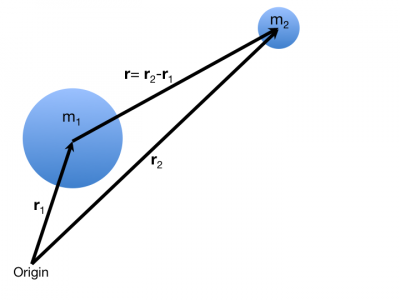This is an old revision of the document!
Gravitational Acceleration
Earlier, you read about Newton's Universal Law of Gravitation or, rather, the model we use to describe the gravitational interaction between two objects with mass. In these notes, you will read about how the gravitational acceleration of system depends only on the system that attracts it and the relative position of the systems.
The Gravitational Force and the Momentum Principle
As you read earlier, the gravitational force between two objects with mass is given by the vector expression:
$$\vec{F}_{grav} = -G\dfrac{m_1 m_2}{|\vec{r}|^2}\hat{r}$$
where object 1 has mass, $m_1$, and object 2 has mass, $m_2$. If the separation vector ($\vec{r}$) describes the relative position of object 2 with respect to object 1 (as shown in the figure to the right):
$$\vec{r} = \vec{r}_2 - \vec{r}_1$$
then the force expression above describes the force that object 1 exerts on object 2. You can use The Momentum Principle to determine the acceleration of object 2 as a result of the gravitational force exerted by object 11).
$$\vec{F}_{net,2} = \vec{F}_{grav,2}$$ $$m_2 \vec{a} = -G\dfrac{m_1 m_2}{|\vec{r}|^2}\hat{r}$$ $$\vec{a} = -G\dfrac{m_1}{|\vec{r}|^2}\hat{r}$$
